Onion Growth Stages
Embarking on the journey of cultivating onions in my home vegetable garden opens up a world of possibilities. Whether you fancy traditional bulb onions or the versatile bunching onions, I will unravel the onion plant growth stages, offering valuable insights for successful cultivation from seeds or sets. Join me as we delve into growing onions and navigate through the Onion Growth Stages.
Conditions for Growing Onions
When embarking on onion cultivation, the foundation must be laid properly to set up plants for success. Choosing suitable varieties, providing adequate sunlight, preparing the soil composition, meeting nutritional needs through amendments, and utilizing raised beds can get my crop off to a vigorous start.
Popular home garden varieties of bulb onions include Copra, Patterson, and Red Wing, which produce sizable, pungent bulbs. Bunching onions like Evergreen Hardy White and Parade offer crisp stalks and fresh green tops perfect for salads and garnishes. I consult regional growing guides to select varieties suited for my climate.
Onions require full sun—at least 6 hours of direct light daily. i choose a spot in my vegetable garden that receives sunlight for most of the day. The soil should be loose, crumbly, and rich in organic matter, with a pH between 6.0-6.8. I mix in several inches of aged compost or nutrient-rich planting mix if my soil is dense or nutrient-poor.
Onions are heavy feeders, requiring consistent nitrogen for lush vegetative growth. I work a balanced organic fertilizer into the top few inches of soil prior to planting. I side-dress growing plants with a nitrogen-rich fertilizer monthly. Building up long, wide raised beds, I create excellent drainage and air circulation for bulb development.
For more information about Gardening you can visit: Avocado Growth Stages
Onion Plant Growth Stages
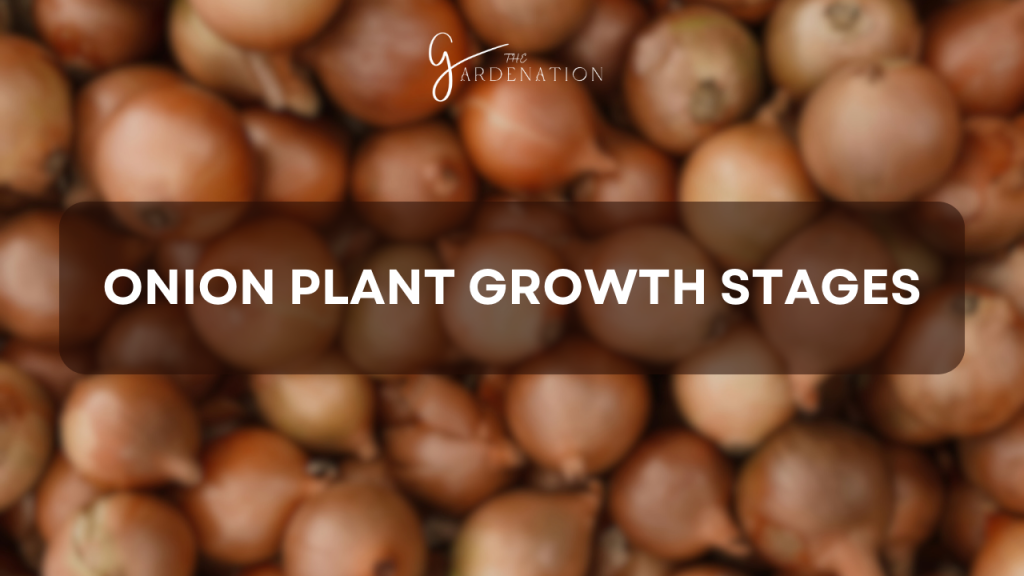
The life cycle of the onion plant progresses through several distinct stages as it journeys from seed to seedling, through vegetative leaf production and bulb formation, into flowering and seed production, and finally senescence. Gaining familiarity with these phases enables attentive care tailored to the plant’s changing needs.
Seed Germination

Onion seeds begin as tiny dried ovules housing embryonic rootlets and shoots. Successful germination depends upon proper sowing depth, soil moisture, temperature, and airflow.
I time sowing according to climate, starting seeds indoors 8-12 weeks before my last expected frost date. The ideal temperature range for onion seed germination is 50-95°F. I keep soil evenly moist but not saturated. Germination occurs best when seeds are pressed into close contact with moistened soil particles. I expect emergence within 7-10 days when conditions are favorable.
While starting seeds indoors provides protection, onions often transplant poorly if overgrown. I sow seeds shallowly into cell packs or flats, then I transplant seedlings into the garden just as their first true leaves emerge.
Seedlings
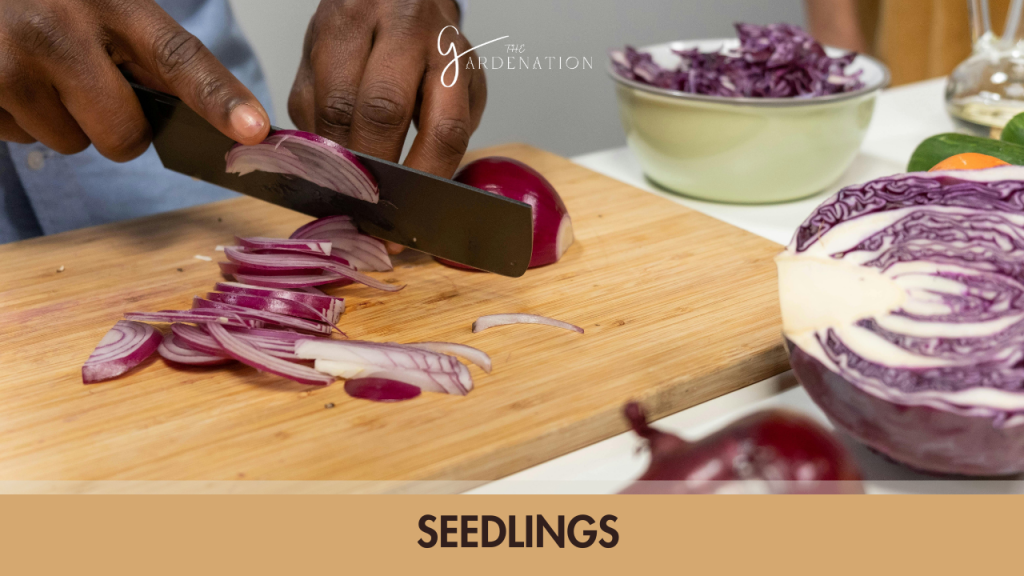
About 5-7 days after germination, the first seedling leaves (cotyledons) unfurl. These fat, rounded leaves differ in appearance from the slender, blue-green true leaves that subsequently develop.
Onion seedlings require bright light and moderate fertility to avoid stretchy, weak growth. I use a seedling fertilizer at half-strength about two weeks after emergence when the first true leaves appear. Trimming the long, grassy tops of seedlings to 6 inches tall about a month before transplanting often help me in better bulb formation later on.
Vegetative Growth
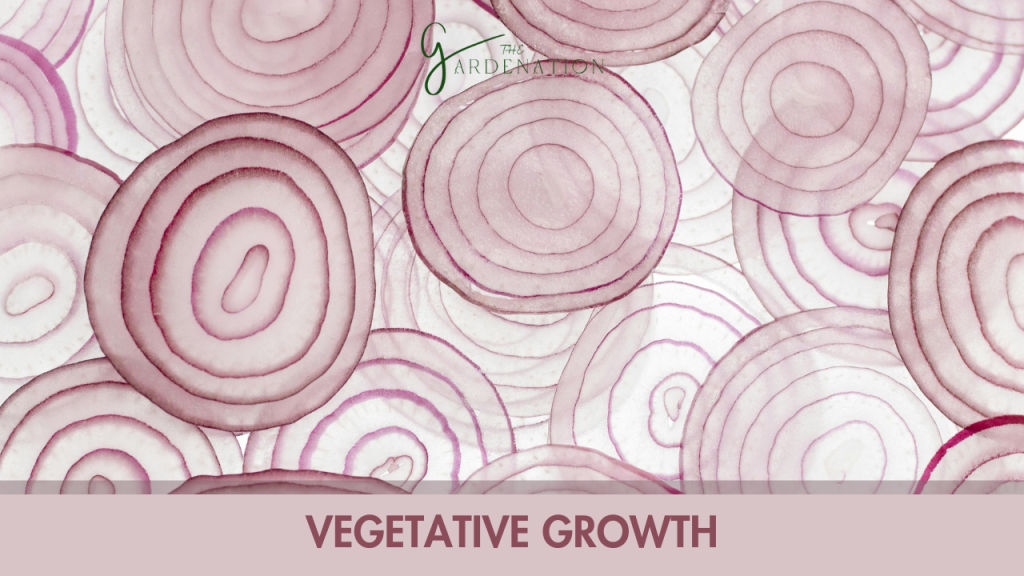
During vegetative growth, the onion plant focuses its energy on leaf, stem, and root development in preparation for the bulb enlargement stage. Robust vegetative growth sets the stage for bulb success.
The flat, pointed, blue-green leaves of onion plants are critical for photosynthesis. Healthy leaves translate to good bulbs. I avoid over-fertilizing with nitrogen, which causes excessive leaf growth at the expense of the bulb.
Bulb Formation
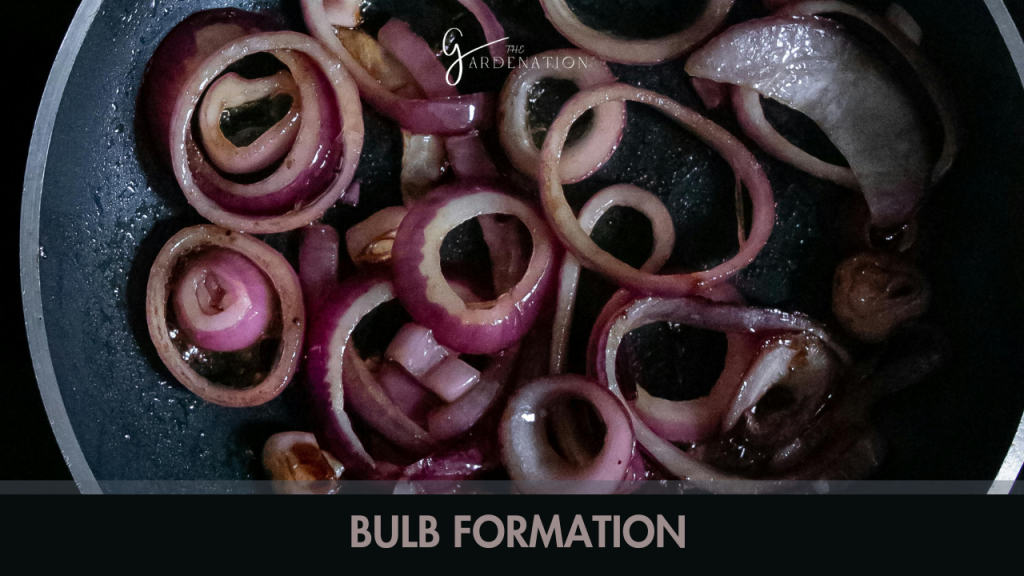
When an onion plant receives its required daylength and achieves sufficient maturity, bulb formation commences. This stage is highly dependent on variety and climate.
The swelling bulb dominates the plant’s resources, causing foliage to fall over. This physiological shift is triggered by complex soil reactions and hormonal changes influenced by daylength, fertility, and temperature. Onions form in response to long days, while shortening fall days stimulate maturation.
Flowering
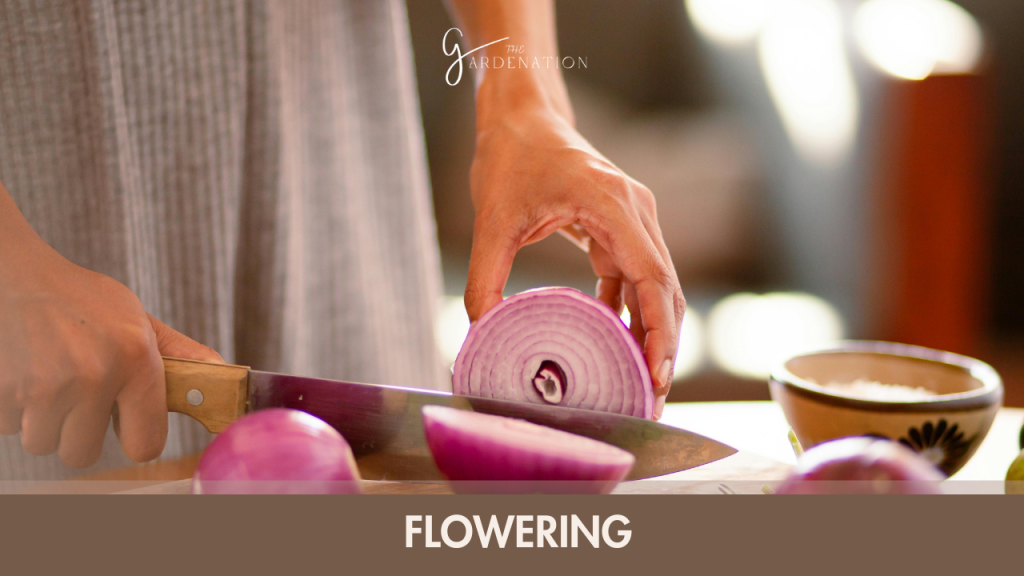
Left to complete their biennial life cycle, onion bulbs will send up a tall central stalk topped by a classic globe-shaped cluster of starry white blooms the second season. However, most onions grown for consumption are harvested in their first season, long before flowering occurs. Stress factors like drought, high temperatures, and nutrient deficiencies can prematurely trigger bolting (flowering).
Pollination
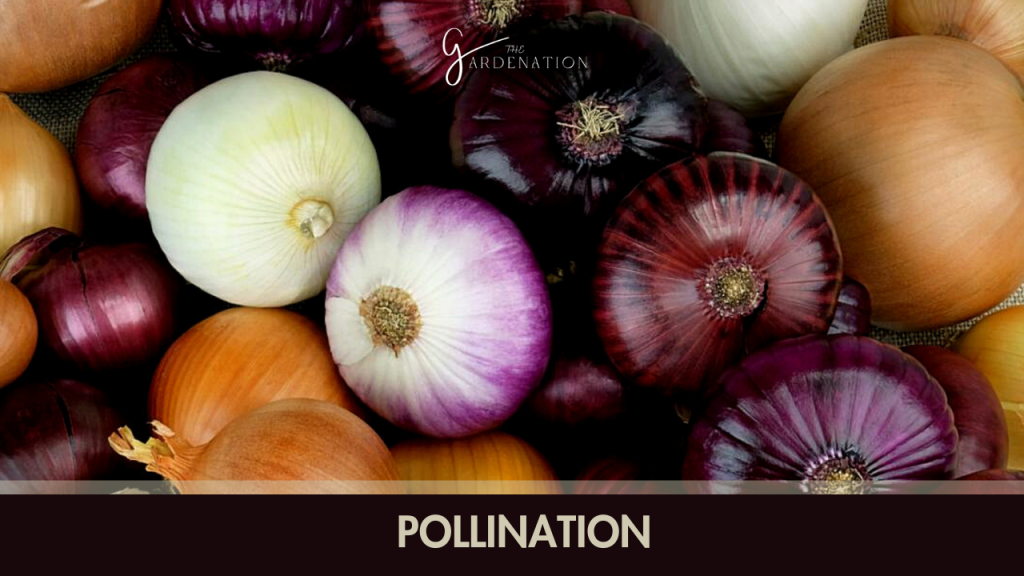
If flowering does progress, small six-petaled blooms open to release pollen which fertilizes the flowers. Onions are self-fertile but also benefit from cross-pollination between plants. Insects aid fertilization, while wind and rain also spread pollen.
Seed Development
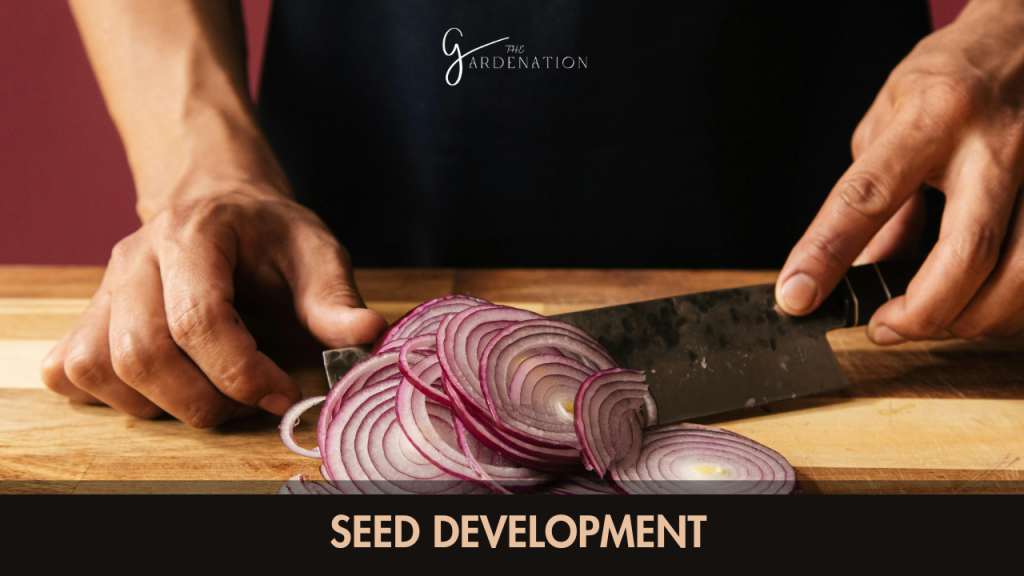
Once fertilized, flowers develop into seed capsules housing small, black onion seeds. Each capsule contains several seeds which are dispersed when mature. Onion seeds exhibit high viability the first year after harvest but decline sharply thereafter.
Harvesting Know-How: When and How to Harvest Onions
Identifying maturity signs and utilizing proper harvesting techniques ensures prime onion quality at peak ripeness while avoiding damage.
Bulb Onions: Signs of Readiness and Harvesting Practices
Onions signal readiness through soft necks, fallen foliage, and light bulb color. I use a digging fork to loosen soil and lift bulbs by their necks. I spread plants on screens to dry for 1-2 weeks until outer skins rustle. I store cured bulbs in a cool, dry area in mesh bags.
Addressing Bolting in Onions
Premature seed stalk emergence ruins bulbs for fresh use but does not preclude dehydrated onion usage. I simply snip off any bolting stems to redirect energy, or harvest bolting bulbs early for pickling or cooking applications where appearance matters less.
Bunching Onions: Harvesting Techniques for Extended Yield
Bunching onions offer their slender green tops and shanks over an extended window. I simply use scissors or a sharp knife to snip desired amounts of foliage and immature stalk approximately 1 inch above the bulb. I take care to leave growing points intact for continuous regrowth.
Understanding Onion Categories
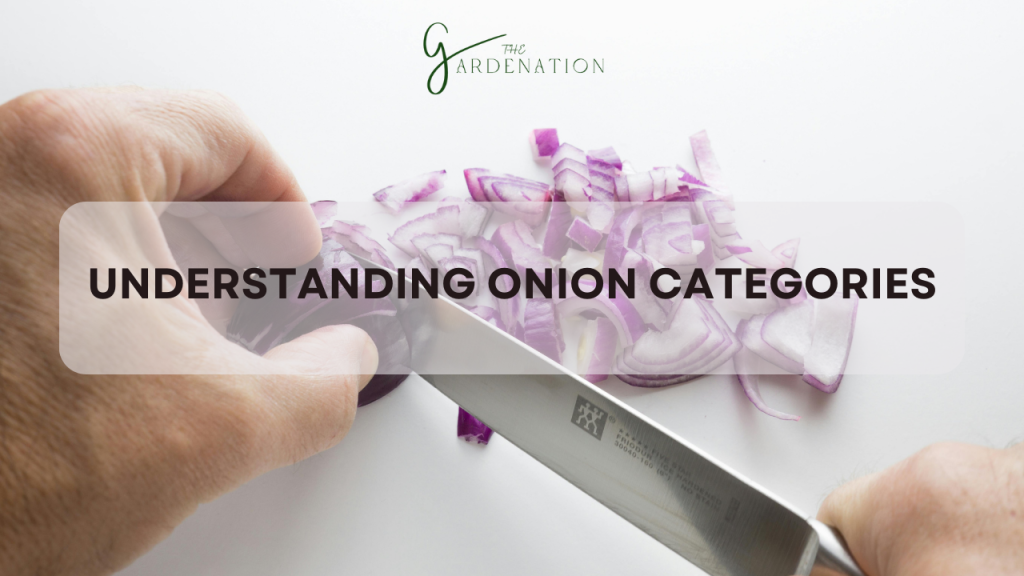
Onions belong to two broad categories—bulb onions and bunching onions. Bulb onions form swollen leaf bases, or bulbs, which are harvested when mature. Bunching onions produce tender green tops and slender shanks harvested while juvenile.
Bulb Onions
Bulb onions require 90+ days to reach maturity. They are grouped by day length requirement:
Short-day varieties initiate bulbs when daylight is 10-12 hours long, suitable for southern regions.
Day-neutral hybrids form bulbs regardless of day length.
Long-day types require 14+ hours of light to bulb and are adapted for northern climates.
Bunching Onions
Bunching onions deliver crisp greens and shanks in just 60-110 days. Evergreen Hardy White and Parade are two flavorful, cold-tolerant varieties.
Planting Methods
Onions can be cultivated from tiny seeds or mature bulbs called sets. Both have advantages and disadvantages.
The Versatility of Onion Seeds
Seeds offer greater variety selection, ideal for northern gardeners needing long-day adaption. Starting seeds indoors extends the growing season. However, germination is tedious and seedlings require diligent care.
Growth with Onion Sets
Sets are essentially dormant onion bulbs that establish quickly, eliminating fussy seedling issues. However, variety selection is limited, and large sets often bolt before bulbing.
Seeds vs. sets debate
Experts conclude both methods have merits for different situations. Seeds enable trialing diverse varieties but demand more time and attention. Sets are extremely convenient but limit options primarily to short-day cultivars.
Onion Growing Tips

Like all crops, onions can encounter challenges that jeopardize productivity. I arm myself with solutions to common problems, along with next-level techniques for maximizing yields.
Addressing Common Onion Growing Challenges
Thrips, nematodes, neck rot, and bolting threaten onions, but preventative care mitigates issues. I ensure adequate fertility, avoid overwatering, rotate plantings, apply floating row covers, and I test soil routinely.
Maximizing Onion Yield
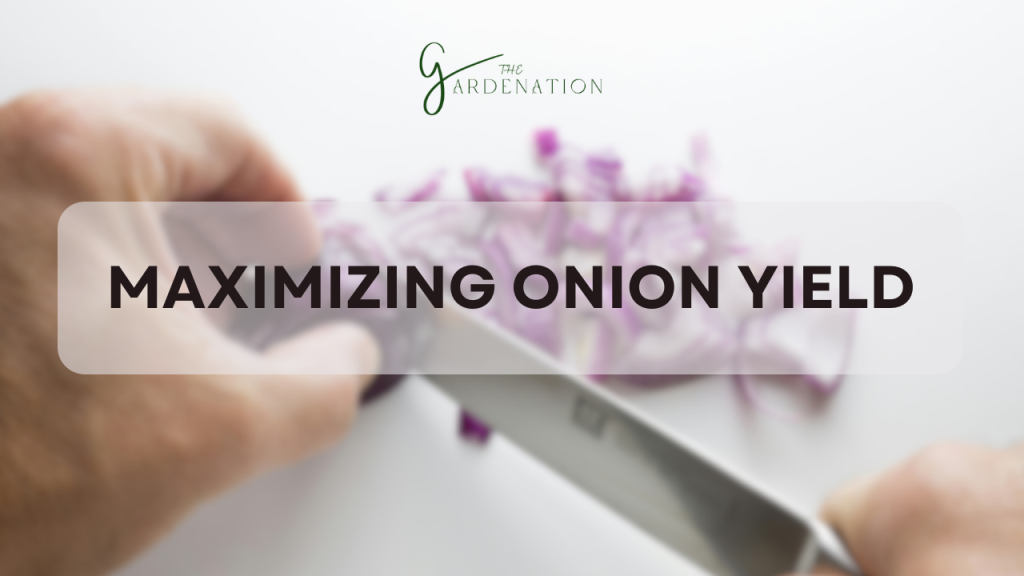
I boost yields, size, and pungency through intensive planting arrangements, supplemental lighting to lengthen days, and special fertilizer blends. I try curing and proper storage to preserve quality.
Companion Planting Strategies
Interplanting compatible flowers, herbs, and vegetables can enhance growth and deter pests. Notable onion companions include dill, chamomile, parsley, lettuce, beets, carrots, leeks, and chives.
Expert Insights
Integrating scientific research into onion cultivation practices improves success. Experts provide key recommendations:
- For best growth, onions require soil pH between 6.0-6.8 to access necessary nutrients.
- Starting seeds indoors under grow lights 8-12 weeks before transplanting gives northern gardeners a head start.
- Whether planting seeds or sets, I take care not to space onions too densely. Proper air circulation is key.
While the seeds vs. sets debate continues, each method has advantages that appeal depending on the gardener’s needs and constraints. Both can produce excellent homegrown onions with careful attention.
Frequently Asked Questions
How Many Onions Do You Get From Planting One Bulb?
A single mature onion bulb can multiply into 6-12 bulbs if left to grow a second season. However, most onions are grown as annuals and harvested in their first year before multiplying occurs.
Understanding the Timeline: How Long Do Onions Take to Grow?
Onions grown from seed take 90-120 days from sowing to harvest. Sets mature slightly quicker at 80-110 days since they skip the seedling stage. Bunching onions grow even faster, yielding green tops and shanks just 60-80 days from planting.
Conclusion
While intricate, unlocking the sequence of onion growth stages is tremendously rewarding. Implementing good foundational practices, tracking vegetative and reproductive phases, and properly harvesting ample bulbs or bundles of greens offers me distinctive, pungent flavors through the seasons. I celebrate my bountiful harvest of beautiful biennials!
Whether you are a novice gardener or an experienced enthusiast, the stages of onion plant growth unfold a fascinating story of botanical marvels in your very own backyard. Let the flavors of homegrown onions elevate your culinary adventures and gardening joy.


2 Comments